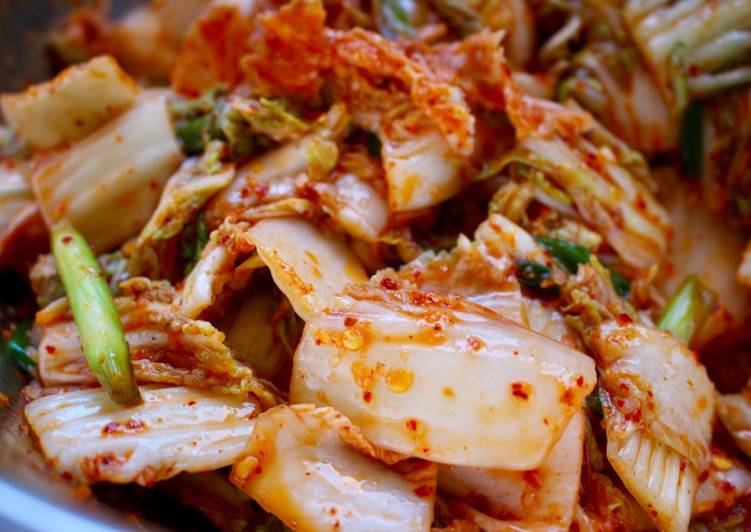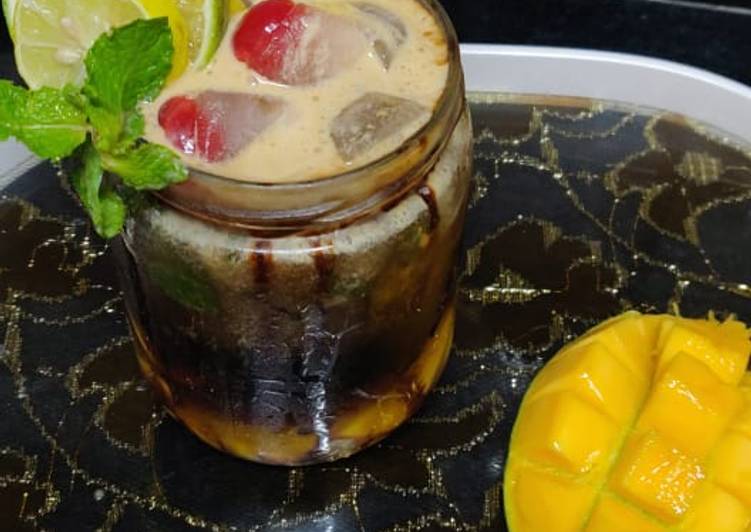
Hello everybody, I hope you’re having an incredible day today. Today, I’m gonna show you how to prepare a special dish, kimchi (easier than you think! ;) ). It is one of my favorites food recipes. For mine, I am going to make it a little bit tasty. This will be really delicious.
Kimchi is a traditional Korean dish of fermented vegetables and spices, in particular ginger, garlic, peppers and hot chilies. Kimchi: AKA fermented cabbage, is one of the healthiest foods for your gut. Chef Randy Feltis shares how to make the dish yourself.
Kimchi (Easier than you think! ;) ) is one of the most popular of current trending meals on earth. It’s simple, it is quick, it tastes yummy. It’s enjoyed by millions daily. Kimchi (Easier than you think! ;) ) is something which I’ve loved my whole life. They are fine and they look wonderful.
To get started with this recipe, we have to prepare a few ingredients. You can have kimchi (easier than you think! ;) ) using 11 ingredients and 9 steps. Here is how you cook that.
The ingredients needed to make Kimchi (Easier than you think! ;) ):
- Get 4-5 pounds Napa cabbage, cut into roughly 1"x 2" pieces (about 30 cups of chopped raw cabbage)
- Prepare 1 bunch green onions, washed, roots trimmed, and cut into 2 inch segments
- Take 5 Tablespoons kosher salt (about 10% less if you're using regular table salt)
- Prepare For the paste:
- Make ready 1/4 cup minced garlic (about 5 or 6 large cloves)
- Make ready 1/4 cup minced fresh ginger root (about a 2" segment, peeled)
- Make ready 1/4-1/2 cup crushed red chili flakes depending on how hot you want your kimchi. See notes above re: gochugaru
- Get 1/4 cup steamed white rice, lightly packed. Short or long grain is fine. If stale, microwave with 2 Tbsp. water for 1 minute
- Prepare 1/4 cup fish sauce
- Get 1/4 cup sugar
- Make ready 1/4 cup water for blending + 1/3 cup water for rinsing seasoning from bowl (see directions below)
Before we talk about specific factors that make learning Mandarin easier than you might think, I'm going These are just some of the more obvious reasons that reaching a basic level in Chinese is not as difficult as you think. It is with asset flip, premade stuff and easy game engines,but that will be non sense. This controlled method of helping food decompose is also much easier (and less gross) than you think. These larger-scale operations???often run in tandem with regular curbside garbage pickup???accept more types of food scraps than you can easily handle.
Steps to make Kimchi (Easier than you think! ;) ):
- In a large stainless steel or mixing bowl, toss the raw cabbage, green onion, and the salt together to pre-brine the cabbage. Make sure to thoroughly incorporate the salt throughout the cabbage. In 10 to 15 minutes, you should start to see the cabbage leach liquid and wilt. Let the cabbage sit for 1.5 to 2 hours, tossing and redistributing every 30 minutes to ensure even brining.
- After at least 90 minutes of pre-brining, rinse the cabbage with enough water to cover the cabbage by 4 or 5 inches by swishing the cabbage in the water 7 or 8 times. Remove the cabbage into a strainer and let the excess water drain while you prepare the paste.
- Make the paste by putting all the paste ingredients into a blender and blend until you can't see the individual grains of rice. Pour the paste over the cabbage.
- Get into the bowl with your hands and mix the paste into the cabbage until all the pieces are evenly and thoroughly coated.
- Pack your kimchi into a clean, dry bottle or other tight-lidded container (this time I repurposed a half gallon kimchi jar) and use the last 1/3 cup of water to swish around the mixing bowl, pick up all the remaining paste, and pour that liquid on top of your kimchi. Remember to leave 2 to 3 inches of headspace at the top to allow for expansion as fermentation takes place.
- Your batch of kimchi is now ready for fermentation in a dark but not cold place like the inside of your cupboard. Or, if you can find a warmish spot in your garage, you can put it there. (I know that's not always possible for cold climate people in the middle of winter.) As it ripens, it's a good idea keep the lid slightly unscrewed to relieve the pressurization caused by fermentation. (Your jar can literally explode from the pressure on a specially active fermentation day.)
- People often ask HOW RIPE DOES THE KIMCHI HAVE TO BE BEFORE I REFRIGERATE OR EAT IT? You can eat the kimchi whenever you want. Fresh, just after it's been made, all the way up to when it's so incredibly old, ripe and stinky you could choke out a subway system by placing an open jar in one of the vents. It remains safe for human consumption for A VERY LONG TIME.
- But as to when to refrigerate, just go out once a day every day to taste a piece, and when it gets to the ripeness you like, stick it in the fridge. It'll continue to ripen, but very slowly.
- Enjoy! :)
Below are four easy steps you should take to prepare your ShortStack lists for the GDPR. I suggest making these updates NOW so you can continue Your data will not be used for reasons other than contest administration by [YOUR BUSINESS]. Specifically, your data will be used to help choose and. Wouldn't that be much easier, than the nightmarish 'system' of spelling and pronunciation we use now? Rather than embarking on lengthy or costly self-improvement projects, he suggests trying out smaller, simpler adjustments that he believes can make a real difference in everything from one's Interesting book, easy to read.
So that’s going to wrap it up with this exceptional food kimchi (easier than you think! ;) ) recipe. Thank you very much for your time. I’m confident you will make this at home. There is gonna be more interesting food in home recipes coming up. Don’t forget to bookmark this page in your browser, and share it to your family, colleague and friends. Thanks again for reading. Go on get cooking!

